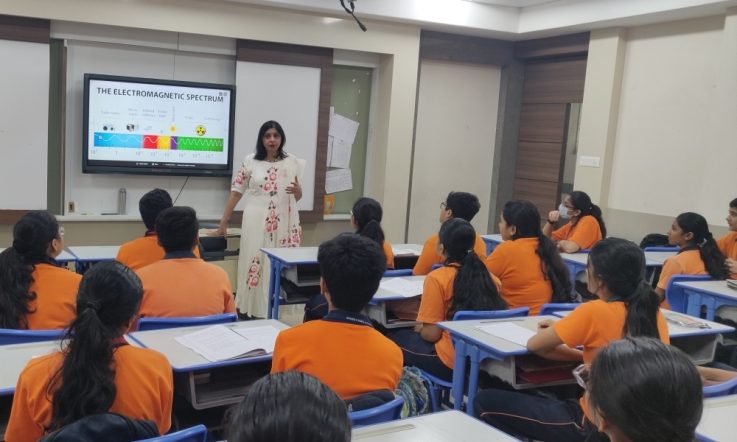In our latest reader contribution Dr Smita Banerjee from The Northstar School in Rajkot, Gujurat, discusses an approach to building Higher Order Thinking Skills that integrates concepts from different curriculum disciplines into thematic units.
At The Northstar School we prioritise efforts to provide opportunities for learners to make connections across different disciplines – fostering Higher Order Thinking Skills such as critical thinking, problem solving, creativity, informed decision making, and a deeper understanding of complex issues. By embracing a holistic view of learning and recognising the interconnectedness of different subject areas, educators can create rich and meaningful learning experiences.
Integrating concepts from different disciplines into thematic units can pique learners' interest and facilitate the development of thinking skills. John Dewey emphasised that integrating an interconnected approach to learning can foster enhanced understanding and retention among children, as they perceive the interrelationships between diverse areas of knowledge (Williams, 2017). Here, I will explore the key characteristics of thematic integration, and how these are created at The Northstar School, Gujarat.
A useful checklist before you begin
The importance of thematic integration is mostly appreciated among the teacher community, although there are several misconceptions on both the design and execution. This checklist can be used to examine your thematic plans.
- An integrated program should include clearly defined learning objectives, ensuring they align with the curriculum standards and desired learning outcomes within the discipline.
- Identify key concepts within the discipline that can be integrated with concepts from other related disciplines.
- Make the theme relevant and engaging to students by selecting topics that resonate with their interests, diverse needs, experiences, and real-world contexts. Consider incorporating current events, local issues, and cultural perspectives to enhance relevance.
- Design instructional activities that accommodate different levels of readiness, learning preferences, and abilities.
- Plan activities that are both teacher-initiated and directed and child-initiated and directed which can give whole class, small group, and individual experiences.
- Consider using a variety of assessment methods, including performance tasks, projects, presentations, and portfolios, to capture the multidimensional nature of student learning.
- Provide opportunities for students to reflect on their learning experiences.
There are numerous strategies to facilitate greater disciplinary integration through thematic presentations. One effective approach involves connecting themes within a single discipline. For instance, concepts like fractions, decimals, and percentages can be intertwined with the theme of ‘Money’ or ‘Time’ as shown below. Additionally, exploring geometric principles such as shapes, angles, and proportions can shed light on their influence in architectural design and construction. Similarly, the examination of different types of forces and Newton’s laws of motion can be enriched by studying ‘Engineering marvels from around the world’, and ‘Calculus in Motion’ offers a compelling exploration, employing concepts such as derivatives, integrals, and rates of change in mechanics to quantitatively analyse and predict the behaviour of physical systems.

A second form of integration is to connect themes across 2 or more disciplines. For example, the theme ‘Graphs in practical situations’ can be connected with Chemistry, Biology, Physics, Mathematics, Economics and Business Studies as shown below. Similarly, a theme of ‘Google Maps’ offers a multifaceted approach to understand spatial relationships, geographical features, and digital mapping technologies.

A possible theme to connect different domains, skills, activities and assessments could be fostering understanding of complex global issues, such as conflicts. For example, organisational skills could be developed through charting the timeline of historical events; depending on the age of students, the skill of analysis and synthesis can be developed by an activity of political cartoon analysis which can further be used to assess by designing political cartoons; students can explore the impact of complex global events on different countries, and their differing perspectives (investigating, justifying/critical thinking); while an activity around reading extracts from Anne Frank’s The Diary of a Young Girl could lead to an assessment where students are asked to write their own diary entries (metacognitive skills).
We can use the following template to outline our assessment strategy, emphasising the targeted learning outcomes/skills achieved through activities aligned with the curriculum objectives.

These types of thematic projects are taken in The Northstar School, Gujarat by every grade and in every semester. This interdisciplinary project comprises learning outcomes from different domains, along with subject competencies and the duration to complete is roughly 15 days.
Mitigating potential challenges
In our experience, educators can encounter several challenges in managing parental expectations, coordinating thematic plans with time constraints, collaborating with fellow educators, and completion of the board curriculum. However, several strategies can help mitigate these challenges:
- Provide parents with a letter outlining program goals and curriculum areas, elucidating the benefits of an integrated approach for their children's development.
- Share images of classroom activities with the parent community to foster engagement and provide transparency in the learning process.
- By sharing reflective exercises at home, parents can explore the valuable insights into how integrated teaching methods enhance their child's learning across various subjects and domains.
- We have found that allocating Saturdays for collaborative planning sessions facilitates cohesive thematic planning among educators.
The different stages of planning
Thematic planning involves several stages. Here’s an outline with some activities you and your colleagues could be thinking about.
Macro-level collaborative planning (15-30 minutes) involves identifying integrated themes and domains. Prepare a concept map for separate domains highlighting the key domain concepts and domain competencies. Check if there is any overlapping area between the domain concepts
Micro-level collaborative planning (1 hour) includes sequencing topics across domains and defining session objectives. Map the domain concepts contained in the topic and make visible the possible connections so that the order seems a continuous flow of thoughts
Micro-level individual/collaborative activity planning (1 hour) entails designing experiences for the whole class, groups, and individuals. Use different thinking routines, hands on discussions, and so on, which can enhance subject competencies and Higher Order Thinking Skills.
Mico-level logistic planning, handled by administrative staff, addresses scheduling and resource allocation.
By employing these strategies, educators can navigate the challenges more effectively and create enriching learning environments for their students.
References and related reading
Button, L. (2021). Curriculum Design, Development and Models: Planning for Student Learning. Curriculum Essentials: A Journey. PressbooksOER. https://oer.pressbooks.pub/curriculumessentials/chapter/curriculum-design-development-and-models-planning-for-student-learning/
Drake, S. M., & Reid, J. L. (2018). Integrated curriculum as an effective way to teach 21st Century capabilities. Asia Pacific Journal of Educational Research, 1(1), 31-50. 10.30777/APJER.2018.1.1.03
Williams, M. K. (2017). John Dewey in the 21st century. Journal of Inquiry and Action in Education, 9(1), 7. https://digitalcommons.buffalostate.edu/jiae/vol9/iss1/7/



